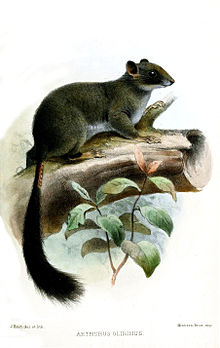Zenkerella (animal)
| Cameroon scaly-tail Temporal range: Early Miocene - Recent (for the genus) |
|
|---|---|
 |
|
| Scientific classification | |
| Kingdom: | Animalia |
| Phylum: | Chordata |
| Class: | Mammalia |
| Order: | Rodentia |
| Family: | Zenkerellidae |
| Subfamily: | Zenkerellinae |
| Genus: |
Zenkerella Matschie, 1898 |
| Species: | Z. insignis |
| Binomial name | |
|
Zenkerella insignis Matschie, 1898 |
|
The Cameroon scaly-tail (Zenkerella insignis), also referred to as the Cameroon anomalure, flightless anomalure, or flightless scaly-tail, is a rodent species endemic to West Central Africa. The scientific literature has never (or possibly only obscurely) reported observations of live individuals. The taxonomic classification of the species has been subject to recent revision.
Previous common names for this species included flightless scaly-tail ‘squirrel’, but this is a misnomer as anomalures are very distantly related to the true squirrels of the rodent family Sciuridae and only superficially resemble them.Z. insignis is the only extant species in the genus Zenkerella and family Zenkerellidae and is the only surviving species of a lineage that diverged from the other extant anomalures (genera Idiurus and Anomalurus) ~49 million years ago (Ma). Among mammals, very few species are the sole survivors of such ancient lineages, some other examples being the pen-tailed treeshrew and the monito del monte.
Extinct fossil taxa which are putative close relatives of Z. insignis include: Zenkerella wintoni (~20 Ma, early Miocene, Kenya),Prozenkerella saharaensis (~31 Ma, early Oligocene, Libya), and possibly Oromys zenkerellinopsis (~33 Ma, earliest Oligocene, Morocco).
In 2016, it was reported that three whole-body specimens of Z. insignis were recovered on Bioko Island, Equatorial Guinea. At that time, it had been over 20 years since the scientific literature recorded new individuals. These specimens were used to sequence portions of the Z. insignis genome. Phylogenetic analysis using combined DNA and anatomical data place Zenkerella as the sister taxon of an Idiurus-Anomalurus clade. This is contrary to a previous hypothesis that grouped Zenkerella with Idiurus within the family Anomaluridae. The Z. insignis position in the rodent evolutionary tree supports a single origin of the anomalure gliding adaptation with no evolutionary reversals; more complex evolutionary scenarios were previously envisioned. The same analysis estimated an early Oligocene origin of anomalure gliding and an early Eocene divergence of the Z. insignis lineage. These results were used to justify a taxonomic revision that erected the new rodent family Zenkerellidae in which Z. insignis is the only living species.
...
Wikipedia

